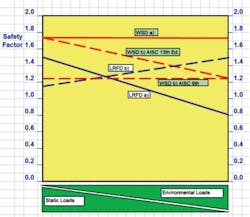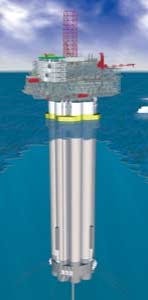Sam Allen - Technip Canada
With a wider development of Arctic oil and gas reserves imminent, offshore operators and contracting companies have been busy planning for what some regard as the final frontier.
When the United States Geological Society (USGS) published its Circum-Arctic Resource Appraisal report in 2008, stating that the Arctic Circle has an estimated 90 Bbbl of undiscovered, technically recoverable oil, 1,669 tcf of natural gas, and 44 Bbbl of natural gas liquids (NGLs), it was clear these figures would generate considerable interest in the Arctic region. To set these potential reserves into context, they represent 13% of the world’s undiscovered oil, 30% of its natural gas, and 20% of its NGLs, with about 84% expected to occur offshore.
With peak oil and a significant increase in energy demand forecast over the long term, it is very likely that the Arctic region will become further developed at some stage in the future. The timing depends on how the economics of individual Arctic projects compare with other global energy projects, together with other factors such as political risk, security of energy supply, and Health, Safety & Environment (HSE) considerations.
As for large energy contracting companies, there will be a need to execute increasingly challenging infrastructure projects, enabling oil and gas production from the Arctic region to be conducted in an economic, safe, and environmentally responsible manner.
Arctic developments
Historically, the oil and gas industry has developed by expanding its existing technologies into new environments. Land-based drilling techniques were moved to offshore locations using wooden platforms linked by jetties to enable production from subsea reservoirs. As water depths increased, steel and concrete structures were introduced using increasingly sophisticated installation vessels.
With the development of flexible pipe, offshore production became feasible from floating platforms. As technologies matured, facilities were located in increasingly deeper waters and harsher environments. So the further development of the Arctic region will also be another step-out of established experience from existing sub-Arctic and Arctic projects.
To assume that the wider development of the Arctic will require a whole new set of technologies and procedures is to ignore the fact that there has already been considerable development of oil and gas reserves within the Arctic Circle. In addition, there have been a significant number of oil field developments in various sub-Arctic areas where some of the environmental conditions and remoteness issues are closely analogous to those experienced further north. Hence the further development of the Arctic is likely to follow a process of evolution rather than revolution.
So when an engineering contractor decides to gear-up its operations to meet the future demand for Arctic infrastructure, a good starting point is to review its track record of existing projects and then analyse the skills, design tools, and installation equipment likely to be required to execute the projects of the future.
Technip’s experience in the Arctic region began in the 1960s with RJ Brown Deepwater’s involvement in installing pipelines below the ice sheet. At this time, 3D layout and finite-element structural modeling did not exist, and scale models of the topography were built to confirm pipeline geometries during the installation process of pulling the lines through and below the ice sheet.
Today, while construction methods employed are very similar to those pioneered in that period, the advent of computer-based tools has revolutionized design. These new tools were extensively employed during the design of and preparation for installation procedures for the Sakhalin I project Phase 1 (Orlan field) pipelines.
During the past decade, the company has been increasingly involved in harsh environment subsea construction projects off the coast of Eastern Canada in the Jeanne D’Arc basin, offshore Sakhalin Island, and in northern Norway. Using its fleet of pipelay and subsea construction vessels, Technip has accumulated considerable experience in operating in extreme cold and relatively remote areas on projects such as Terra Nova, White Rose, White Rose North Amethyst Extension, Sakhalin, and Snohvit.
For example, the Terra Nova project, executed from 1997 through 2001, was the first sub-Arctic subsea mega project. It was the first to use large-scale open glory hole construction for iceberg protection; it indicated that seabed excavation and trenching for pipeline protection in the Arctic would pose significant future challenges. It was also the first project to deploy a FPSO with a disconnectable riser system in a harsh environment.
The subsequent White Rose project was built with strong reference to lessons learned from Terra Nova. Most recently, the White Rose North Amethyst extension project has expanded the knowledge base further. Offshore Sakhalin, construction operations were successfully conducted with significant sea ice coverage. Construction offshore northern Norway brings its own challenges and lessons learned, particularly with respect to project planning and logistics.
It is not necessarily the individual challenges offered by the various environmental elements that make working in such areas so demanding, but the combination of wave, current, wind, fog, ice, soils and short season, all of which make the sub-Arctic and Arctic unique areas of the world for offshore operations. In addition to the environmental challenges, northern Norway, eastern Canada, and Sakhalin are all remote areas with a lack of significant infrastructure and a reduced supply chain to call on.
The lessons learned from these operations in harsh environments in relatively remote locations can be used to better prepare for any future operations undertaken in the Arctic, such as the forthcoming Goliat project offshore northern Norway. Such projects can be considered as the true stepping stones towards the full-scale oil and gas development of the wider Arctic region.
New concepts and tools
As projects move further north into more remote and severe environments, new concepts and design tools will be required.
Technip has developed the Arctic Spar in response to the need for an offshore floating platform that minimizes sheet ice loadings on its hull and hence moorings. The Arctic Spar hull includes a reinforced conical section at sea level specifically designed to break sheet ice and ice ridges in a downward direction. This, coupled with the hull’s small cross-sectional area at this level, minimizes the mooring line loads, allowing the platform to remain on station and continue production longer during onerous ice flows, rather than disconnecting.
Technip’s 3D continuum modeling software can be used to analyze the effects of ice scour on pipelines, and to optimize geometries for preventing ice build-up against fixed platform structures.
The ability to cope with more severe ice flow conditions also reduces the reliance on ice management vessels with their high operating costs and large carbon footprint. As a last resort, a detachable keel has been developed that allows the risers and moorings to be disconnected, in the event of an exceptional ice flow condition or iceberg threat.
In Arctic regions such as the Labrador Sea where sheet ice is not routinely experienced but iceberg risk is high, an alternative Arctic Spar design can be used without the reinforced conical section for ice breaking. With this option, the risers and moorings can be disconnected via a detachable lower keel section to allow the platform to be towed clear of an iceberg threat. This option includes a hull form designed for concrete construction suited to local fabrication yard capabilities in Newfoundland. All Arctic spar types can be configured with oil or condensate storage where pipeline export is not envisioned.
With Arctic infrastructure subject to ice flows, it is necessary to have design tools to predict the loadings imposed on structural elements. A 3D continuum modeling tool has been developed that provides solutions to complex design problems involving ice scour, ice loadings on subsea and surface facilities, permafrost degradation, and frost heave.
This finite element ice design tool can be used to analyze ice flows that affect pipelines (e.g. ice scour). It can also simulate ice behavior around fixed platform structures to optimize geometries that can most efficiently break the ice sheet and thereby minimize structural and foundation loadings. The design tool can also assess floating platform structures and artificial islands.
Much is made of the potential mitigating effects from a receding ice sheet in the Arctic, of opening up shipping lanes, and extending the operating seasons for certain vessel operations. However, while sheet ice prevalent and design loads may diminish, the collapse of the ice table will increase the frequency and risk from iceberg impacts and may trigger other changes to the weather system at high latitudes. Indeed it may be some time before an accurate picture emerges of future weather patterns and environmental conditions in the Arctic region. In the meantime, designs will need to be based largely on historical data.
And as construction vessels and operating installations move further north, so the severity of the climate requires additional measures to protect plant, equipment, and personnel. On the Shtokman project, special measures such as roofs and perforated side panels are specified to enclose the production equipment and protect against snow and ice accumulation. However, the desire to protect against the elements has to be balanced against a restriction in natural ventilation that can increase the risk of fire and explosion. Attention must be paid to anti-icing measures; heat-tracing systems should be considered as under-floor heating to keep walkways ice free.
Other challenges for Arctic projects are the safe transfer of personnel to and from an offshore installation (at crew changeover) that may be beyond the range of conventional helicopters. Also, the safe evacuation of personnel during an incident is a challenge when an offshore platform may be surrounded either by sheet ice or by sea with sheet ice fragments and icebergs.
Extreme low temperatures also pose challenges in terms of material selection for plant equipment. To help address these challenges, Technip is involved in several research initiatives to qualify pipeline materials, such as reeled pipe, for low temperature installation and operation.
Planning issues
As the industry anticipates further development of the Arctic, there will be continued focus on the following issues, with HSE always the top priority:
- Building on existing experience of Arctic and sub-Arctic projects
- Review of Arctic capabilities when upgrading or renewing of fleets (e.g. equipment and personnel protection, and Ice Class hull designs)
- Selection of materials for pipelines to match the severe temperatures and loadings during installation and operation
- Pipeline flow assurance
- Trenching challenges for pipeline protection
- Maintenance and intervention on subsea facilities – use of AUVs
- Implementing new platform concepts better suited for Arctic deployment
- Continuing to refine ice design tools
- Developing strategies to enable safe and environmentally responsible operation in remote locations (i.e. logistics, planning, management, and HSE).
References
US Geological Survey Report/Fact Sheet 2008-3049, “Circum-Arctic Resource Appraisal: Estimates of Undiscovered Oil and Gas North of the Arctic Circle,” by (in alphabetical order) Kenneth J. Bird, Ronald R. Charpentier, Donald L. Gautier (CARA Project Chief), David W. Houseknecht, Timothy R. Klett, Janet K. Pitman, Thomas E. Moore, Christopher J. Schenk, Marilyn E. Tennyson, and Craig J. Wandrey (2008).
TS-CR, “Ice & iceberg resistant platform concept for Arctic conditions,” presented at the ROOGD-2006 Conference, April 12, 2006, by Kjell I Stokke & Dagfinn Sveen of Hydro Oil & Energy.
Offshore Articles Archives
View Oil and Gas Articles on PennEnergy.com







